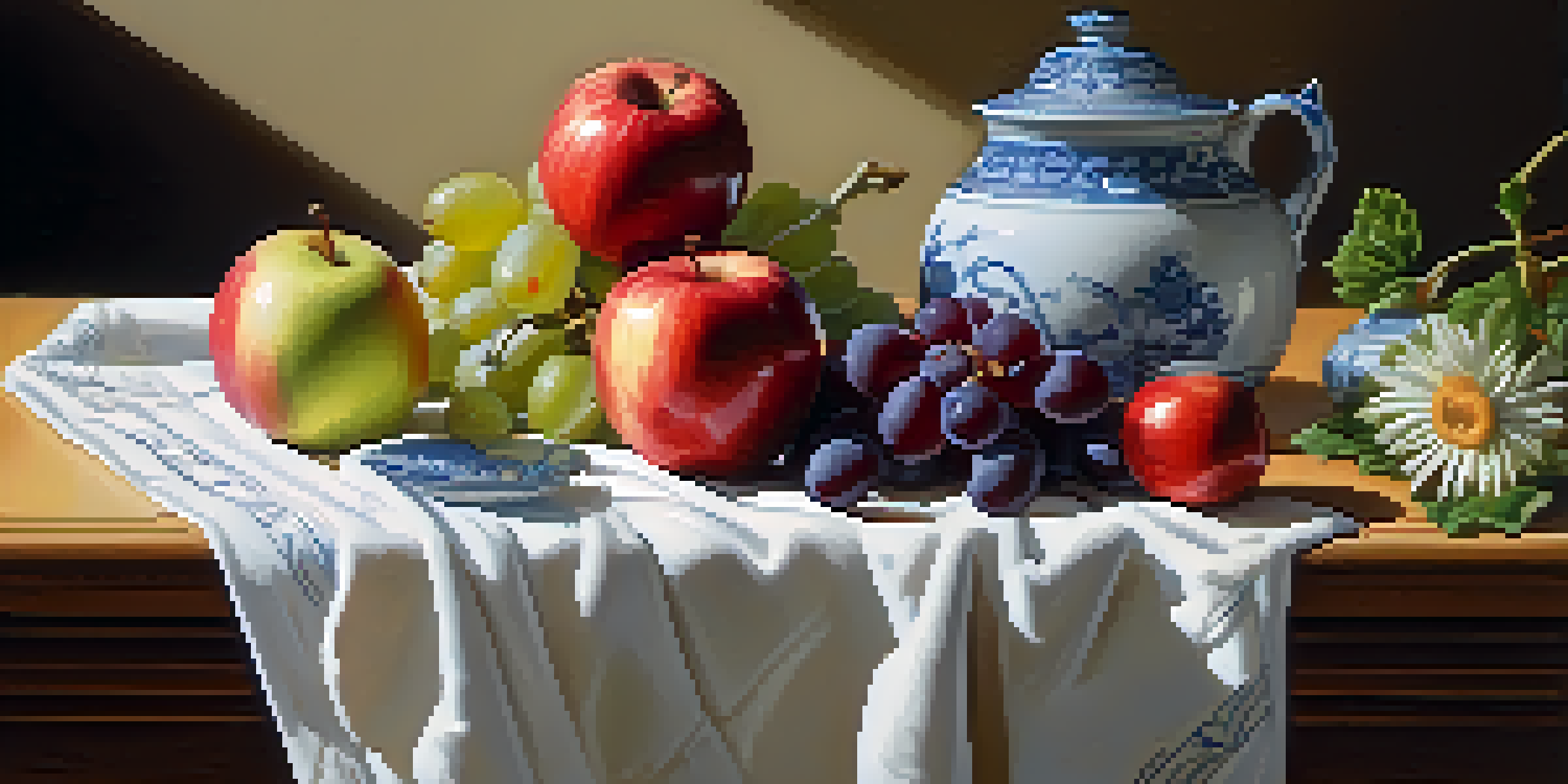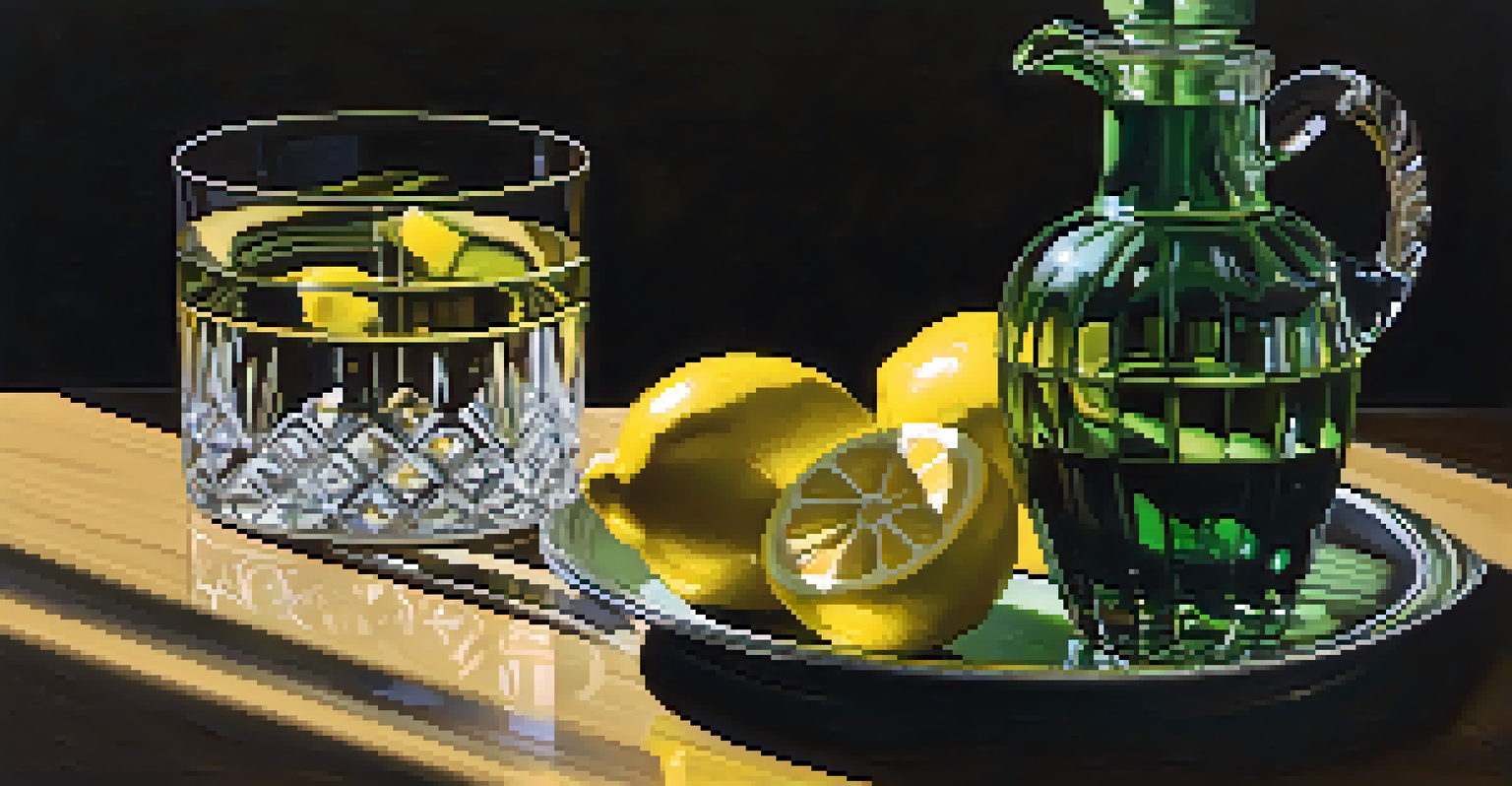The Role of Light and Shadow in Still Life Art

Understanding Still Life Art and Its Importance
Still life art is a genre that focuses on inanimate objects, often arranged in a way that highlights their forms, colors, and textures. This art form allows artists to explore composition and symbolism in a controlled environment. By examining everyday items, artists can convey deeper meanings or emotions, making still life a crucial aspect of art history.
Light is the first element of design; without it, there is no color, no form, no texture.
The beauty of still life lies in its simplicity; it invites viewers to appreciate the ordinary. Objects like fruits, flowers, or household items become focal points that tell stories or evoke feelings. This intimate portrayal reflects the artist's perspective and can resonate with the audience on a personal level.
Moreover, still life art serves as a foundational practice for artists. It helps them develop skills in observation, composition, and the manipulation of light and shadow. Mastering these elements is essential for any artist, as they lay the groundwork for more complex forms of expression.
The Significance of Light in Still Life Compositions
Light is perhaps the most crucial element in still life art, as it defines the mood and atmosphere of a piece. It can create a sense of warmth or coldness, depending on its source and intensity. By manipulating light, artists can guide the viewer's eye, emphasizing certain elements while downplaying others.

For example, natural light can produce soft shadows that lend a sense of realism, while stark, artificial light might create dramatic contrasts. This interplay can evoke emotions, such as tranquility or tension, making the viewer feel connected to the artwork. Artists often experiment with different lighting scenarios to discover what works best for their vision.
Light Defines Mood and Depth
Light is essential in still life art, shaping the mood and depth of a composition through its source and intensity.
Additionally, the direction of light plays a vital role in shaping the perception of depth and volume in a still life. Light hitting an object from one side can create a three-dimensional effect, making the scene more lifelike. In essence, light transforms flat objects into dynamic subjects that engage the viewer's attention.
How Shadows Enhance the Narrative of Still Life Art
Shadows are not merely the absence of light; they are integral to the storytelling in still life art. They add depth, dimension, and context, allowing viewers to understand the spatial relationships between objects. A well-placed shadow can suggest the time of day or create a mood that complements the overall composition.
The shadow is the thing that makes the light interesting.
For instance, a soft shadow may convey a sense of calm, while a harsh shadow could imply drama or tension. Artists often use shadows to evoke an emotional response or to highlight the significance of a particular object. This relationship between light and shadow creates a visual dialogue that enriches the viewer's experience.
Moreover, shadows can serve as a tool for abstraction in still life. By exaggerating or manipulating shadows, artists can create a sense of mystery or intrigue, prompting viewers to engage more deeply with the artwork. This transformative quality of shadows is what makes them a powerful element in still life compositions.
The Influence of Color in Relation to Light and Shadow
Color is deeply intertwined with light and shadow in still life art, as it affects how we perceive an object. Different colors absorb and reflect light in unique ways, which can alter the appearance of objects depending on the lighting conditions. For instance, a vibrant red apple might look different under the warm glow of sunset versus the cool light of an overcast day.
Artists often choose their color palettes based on the desired emotional impact and the interplay of light and shadow. Warm colors can evoke feelings of comfort, while cool colors might suggest calmness or sadness. This strategic use of color enhances the overall narrative of the piece, drawing the viewer into the artist's intended mood.
Shadows Add Narrative and Depth
Shadows enhance storytelling in still life by providing depth and context, influencing the emotional response of viewers.
Furthermore, the juxtaposition of colors alongside shadows can create striking contrasts that elevate the composition. A bright object surrounded by deep shadows can become a focal point, capturing the viewer's attention. This relationship highlights the importance of thoughtful color choices in conveying meaning and evoking emotion in still life art.
Techniques for Mastering Light and Shadow in Still Life
Mastering light and shadow in still life art requires practice and a keen eye for observation. Artists often start by studying real-life objects under various lighting conditions to understand how light interacts with different surfaces. This hands-on approach helps them develop their skills and improve their ability to replicate these effects on canvas.
One effective technique is to use a single light source, which creates distinct shadows and highlights. This controlled setting allows artists to focus on how light defines shapes and textures. Additionally, artists can experiment with different angles and distances to see how these variables impact the overall composition.
Another common method is to create a value study, where artists sketch the light and dark areas of their composition. This exercise helps them visualize the distribution of light and shadow before committing to color. By establishing a strong foundation in light and shadow, artists can bring their still life compositions to life with depth and dimension.
Historical Examples of Light and Shadow in Still Life
Throughout art history, many renowned artists have employed light and shadow to enhance their still life works. For instance, the Dutch masters of the 17th century, such as Rembrandt and Vermeer, skillfully used chiaroscuro—a technique that emphasizes the contrast between light and dark—to create dramatic effects in their compositions. Their works often featured rich colors and intricate details that captivated viewers.
Similarly, the still lifes of the Baroque period showcase the mastery of light and shadow to evoke emotion and drama. Artists like Francisco de Zurbarán portrayed everyday objects with a reverence that highlighted their beauty and significance. This historical context illustrates how light and shadow have always been essential components in creating impactful art.
Color Interplays with Light and Shadow
The relationship between color, light, and shadow is crucial in still life art, influencing emotional impact and overall composition.
In more contemporary times, artists continue to explore these elements, finding new ways to convey meaning and emotion through light and shadow. The evolution of still life art reflects the ongoing dialogue between tradition and innovation, proving that these fundamental aspects remain relevant across time.
Conclusion: The Lasting Impact of Light and Shadow
Light and shadow are not just technical elements in still life art; they are vital components that shape the viewer's experience. The way these elements interact can transform an ordinary arrangement of objects into a captivating narrative. Artists harness the power of light and shadow to evoke emotions, create depth, and draw attention to their intended subjects.
As we’ve seen, the manipulation of these elements has a rich history, informing the practices of both historical and contemporary artists. Each brushstroke, each play of light, tells a story that invites viewers to engage with the artwork on a deeper level. This connection is what makes still life art so enduring and meaningful.

In essence, understanding the role of light and shadow is crucial for both artists and art enthusiasts alike. It enhances our appreciation for the craft, encouraging us to look beyond the surface and discover the stories hidden within the shadows.